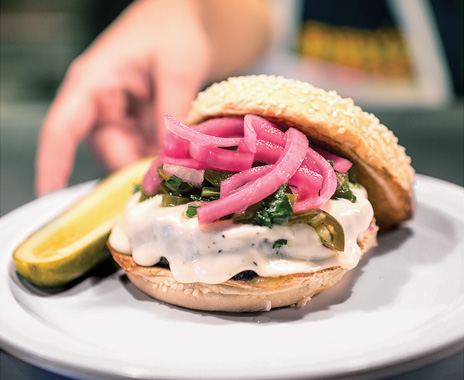First used as a way to preserve foods without refrigeration, pickled vegetables have been a part of the human diet for millennia. Yet pickled vegetables other than the ubiquitous pickled cucumber have only started to appear in American quick serves and fast casuals in the last few years as chefs are finding that this one ingredient can add value to menus in many ways.
1. Pickled vegetables add brightness and excitement to dishes
One reason to add pickled vegetables to a menu is that they add unique flavor, texture, and color to almost any dish.
Robert Kabakoff, executive chef for Bruegger’s Bagels says that the brightening qualities of pickled vegetables are one of the reasons he uses them on the chain’s sandwiches, such as the Harvest Turkey Sandwich and the Bistro Burger, which both feature pickled onions.
“You can pull so much flavor from pickled vegetables that adds another layer to your sandwich,” Kabakoff says. “If you think about our food, you have pastrami, Muenster cheese, and things that are big, rich flavors, and you need that pickled vegetable to give you that little pop of relief.”
Celebrity chef Bobby Flay is also using pickled onions to cut through bold flavors, as well as to add texture and color, to the New Mexico burger at his fast-casual chain called Bobby’s Burger Palace.
“The main reason we added pickled onions to the New Mexico,” Flay says, “is that pickled flavor cuts through the richness of queso sauce. Secondly, it adds crunch. And thirdly, we eat with our eyes too, and the magenta color is magnificent.”
2. Customization options are endless
Another reason pickled vegetables are gaining momentum as a trend is that they can be customized to capture the exact taste that chefs want for individual dishes.
As processes around pickling continue to improve, the availability of quick-pickled custom products that only take three or four days to produce, as opposed to the month needed for traditional pickling, means that customization options are virtually limitless.
“What’s pushing the pickled vegetable trend are uniquely flavored brines along with utilizing different varieties of vegetables, not just the basics like dill pickles or onions,” says Mike Leccese, director of culinary for Haliburton International Foods. “Root vegetables, fruits, legumes, and dried chilies are new ingredients that are hitting the brine.”
But chefs can choose more than just the ingredients that are pickled. They can also work with suppliers to customize unique brines to give pickled vegetables and fruits additional variety.
“The brine is traditionally water, sugar, salt—very basic, but we’re moving into diverse flavor profiles that are not necessarily over-indulgent with vinegars,” Leccese says. “Sometimes we use citrus juices, such as orange, pineapple, and lime. We also use vegetable and chili purees to help add body and spicy notes to brines.”
3. They can help your budget
In addition to elevating dishes, the versatile ways pickled vegetables can be used on a menu means operators can save money on ingredient orders. Pickled vegetables can be used in sandwiches, salads, and a variety of dishes, but even the brine can be used as an ingredient in other offerings.
For example, Leccese says, “We can customize a brine that could later be used in a vinaigrette, sauce, or as the curing liquid for ceviche.”
By multi-purposing the brine and ingredients across a variety of dishes, operators don’t have to order as many products to create a diverse menu.
As pickled vegetables continue growing in popularity, the innovations will continue along with them, and if history is any indicator of a food’s future performance, the long history of pickling means this trend will not be going away any time soon.
by Peggy Carouthers













